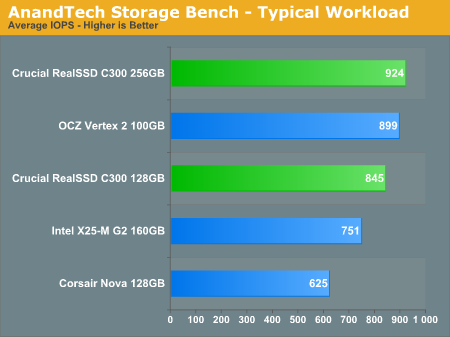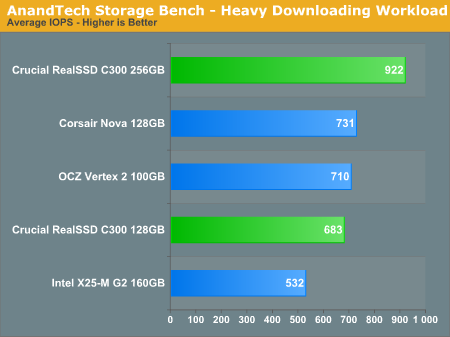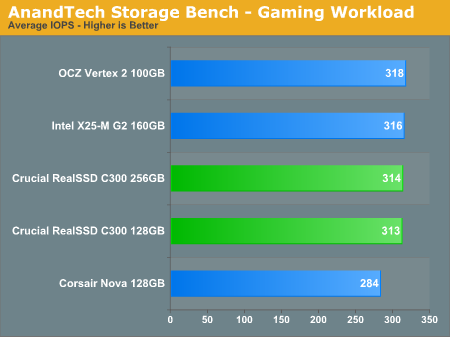The SSD Diaries: Crucial's RealSSD C300
by Anand Lal Shimpi on July 13, 2010 12:39 AM ESTAnandTech Storage Bench
The first in our benchmark suite is a light usage case. The Windows 7 system is loaded with Firefox, Office 2007 and Adobe Reader among other applications. With Firefox we browse web pages like Facebook, AnandTech, Digg and other sites. Outlook is also running and we use it to check emails, create and send a message with a PDF attachment. Adobe Reader is used to view some PDFs. Excel 2007 is used to create a spreadsheet, graphs and save the document. The same goes for Word 2007. We open and step through a presentation in PowerPoint 2007 received as an email attachment before saving it to the desktop. Finally we watch a bit of a Firefly episode in Windows Media Player 11.
There’s some level of multitasking going on here but it’s not unreasonable by any means. Generally the application tasks proceed linearly, with the exception of things like web browsing which may happen in between one of the other tasks.
The recording is played back on all of our drives here today. Remember that we’re isolating disk performance, all we’re doing is playing back every single disk access that happened in that ~5 minute period of usage. The light workload is composed of 37,501 reads and 20,268 writes. Over 30% of the IOs are 4KB, 11% are 16KB, 22% are 32KB and approximately 13% are 64KB in size. Less than 30% of the operations are absolutely sequential in nature. Average queue depth is 6.09 IOs.
The performance results are reported in average I/O Operations per Second (IOPS):

In our custom test suite we can finally put to rest concerns about the real world behavior of SandForce’s drives. Our light test case makes it pretty clear: in practice the Vertex 2 performs within 3% of the 256GB C300, and is a good 20% faster than the Intel X25-M G2. Keep in mind that we’re looking at raw IO performance and not total system performance here.
If there’s a light usage case there’s bound to be a heavy one. In this test we have Microsoft Security Essentials running in the background with real time virus scanning enabled. We also perform a quick scan in the middle of the test. Firefox, Outlook, Excel, Word and Powerpoint are all used the same as they were in the light test. We add Photoshop CS4 to the mix, opening a bunch of 12MP images, editing them, then saving them as highly compressed JPGs for web publishing. Windows 7’s picture viewer is used to view a bunch of pictures on the hard drive. We use 7-zip to create and extract .7z archives. Downloading is also prominently featured in our heavy test; we download large files from the Internet during portions of the benchmark, as well as use uTorrent to grab a couple of torrents. Some of the applications in use are installed during the benchmark, Windows updates are also installed. Towards the end of the test we launch World of Warcraft, play for a few minutes, then delete the folder. This test also takes into account all of the disk accesses that happen while the OS is booting.
The benchmark is 22 minutes long and it consists of 128,895 read operations and 72,411 write operations. Roughly 44% of all IOs were sequential. Approximately 30% of all accesses were 4KB in size, 12% were 16KB in size, 14% were 32KB and 20% were 64KB. Average queue depth was 3.59.

Our heavy downloading workload involves more heavily compressed files and thus we see the Vertex 2 perform like a 128GB C300. The 256GB C300 just can't be touched.
The gaming workload is made up of 75,206 read operations and only 4,592 write operations. Only 20% of the accesses are 4KB in size, nearly 40% are 64KB and 20% are 32KB. A whopping 69% of the IOs are sequential, meaning this is predominantly a sequential read benchmark. The average queue depth is 7.76 IOs.

Our gaming workload has been SATA bound for the high end SSDs for some time now. If you happen to be baller enough to play games off of an SSD, any of these high end drives will perform the same. Although our custom tests don't work with the 6Gbps Marvell controller, the boost to sequential read speed should be quite visible in gaming workloads with the C300.










51 Comments
View All Comments
Breit - Tuesday, July 13, 2010 - link
There are 4 different Vertex 2 drives from OCZ as i know:-> the standard Vertex 2, which uses MLC flash and has ~13% overprovisioning (~91GB usable capacity for the 100/128GB model)
-> then there is a Vertex 2e, which is the same as the normal Vertex 2, but with a modified firmware for ~7% overprovisioning (~111GB usable capacity for the 100/128GB model)
-> then there is a Vertex 2 pro, wich also uses MLC flash and also has ~13% overprovisioning, but also has a supercap to help out on a sudden power loss (more like an enterprise feature)
-> and an last there is the Vertex 2 EX: this drive uses SLC flash and therefor is way to expensive for normal desktop use
the first 3 should perform nearly identical. the last is supposed to be quite superior in performance, but i havn't seen any reliable performance numbers as of yet - anand? ;).
hotlips69 - Tuesday, July 13, 2010 - link
Thx for the info!Why would anyone buy the Vertex 2 "standard" over the Vertex "2e" if it performs the same, but has a larger usuable capacity?
Would there not be a performance hit if there is only 7% provisioning compared to 13% if the drive got full???
DanNeely - Tuesday, July 13, 2010 - link
In normal desktop use there's no reason to get the standard drive. Sandforce initially designed its controllers for the enterprise market and servers can be much more brutal on a drive than end user computers are. On a server workload the extra scratch space was useful, but when they moved over to consumer drives it had no benefit. The 2e was released with an updated firmware once it became clear the controller was just wasting space.jedighost - Tuesday, July 13, 2010 - link
Let me answer: there will be OCZ 'Vertex 2' firmware updates coming out that will allow you to "switch" between 100GB and 120GB on the same drive. So far no significant performance difference have been found, but time is an interesting factor here, noone had months or years to test it, and users who visit forums and write their experiences are usually not known for torturing their SSDs 24/7 just to see what happens/kill them/wear them out.Based on the data available at the OCZ Support Forums, grab the 100GB or 120GB version, whichever you can cheaper, and later on you will be able to choose how much provisioning you want, 7 or 13%.
When your 120GB Vertex 2 SSD is full and you write 8GBs of data (7% of 128GB) in a short period, yes, then there can be degradation. But how likely is that, really?
Also, in average, you can write an MLC cell 10,000 times before you wear it out. This means, to evenly wear out all the cells of your Vertex 2, you need to write 10,000x120GB=1200 TERABYTES on your drive. Sure, when you only write a smaller than 4KB file, the whole cell has to be rewritten, but still, as a system drive, which is not supposed to contain huge files, in the size of several Gigs (raided Raptors are for that), when will you write 1000 Terabytes? By that time, your SSD is long outdated, because 10 years passed by.
More concretely: if you write 275 GBs EVERYday to your SSD for 10 years, 365 days a year, then you wrote 1000 TBs. Lets say i didn't calculate with a bunch of factors, and I am wrong to 3:1 degree and your drives wears out in 200TBs, that is 100GBs a day for 10 years. When will you "rewrite" the whole size of your SSD in daily usage?
Catch my drift?
Buy your drive and don't worry, just enjoy it, the same as I did. Have regular backups as this is still new technology, but be ready to be blown away if this is going to be your first SSD - you will realize that it was not stronger CPUs and overclocking that was needed to make a system snappy, but eliminating the most-overlooked bottleneck: the old HDD.
jedighost - Tuesday, July 13, 2010 - link
Actually i made a quick calculation: assuming you can write with 100MB/sec to your Vertex 2 continuously, 24/7, it would still take *120 days* to wear out all the cells, writing to them 10,000 times each. No mortal user had the time to try this yet. :))sor - Saturday, December 11, 2010 - link
FYI, in December '09 Micron announced that their MLC write durability increased significantly. Anything that has their 34nm chips (C300, maybe others) will have much better durability than your figures.Drazick - Tuesday, July 13, 2010 - link
It seems the smart move would be waiting for the next generation of SSD's by Intel.Assuming it would be a SATA 3 drives paired with P65 it should beat anything on the table at the moment.
Jonathan Dum - Tuesday, July 13, 2010 - link
Not to mention 25nm NAND from Intel/Micron... longest wait ever. Though I wonder when all the other guys like OCZ will get 25nm?james.jwb - Tuesday, July 13, 2010 - link
Anand, what are your recommendations for around the 60-80GB mark? Any changes from your conclusion above?Phate-13 - Tuesday, July 13, 2010 - link
I will say it again, and keep saying it till it happens. Most people are not interested in 100-300GB SSD (except for lower prices obviously) or in 30-40GB SSD's. It's the 50-80GB ones that most people are interested in. That's about the sweet spot of capacity that is needed.The Crucial RealSSD C300 64GB is x times more interesting then it's bigger brothers, it's much cheaper, not only in absolute terms, but also in capacity/euro. And by far the best buy atm in my eyes.
The line-up I want to see would be about something like this:
- Kingston V-series S2 64GB
- Western Digital SiliconEdge Blue 64GB
- Crucial RealSSD C300 64GB
- OCZ Solid II 60GB
- OCZ Onyx 64GB
- OCZ Agility 2 60GB
- OCZ Vertex 2 60GB
- Corsair Force 60GB
And perhaps some of the other, cheaper Corsair SSD's.